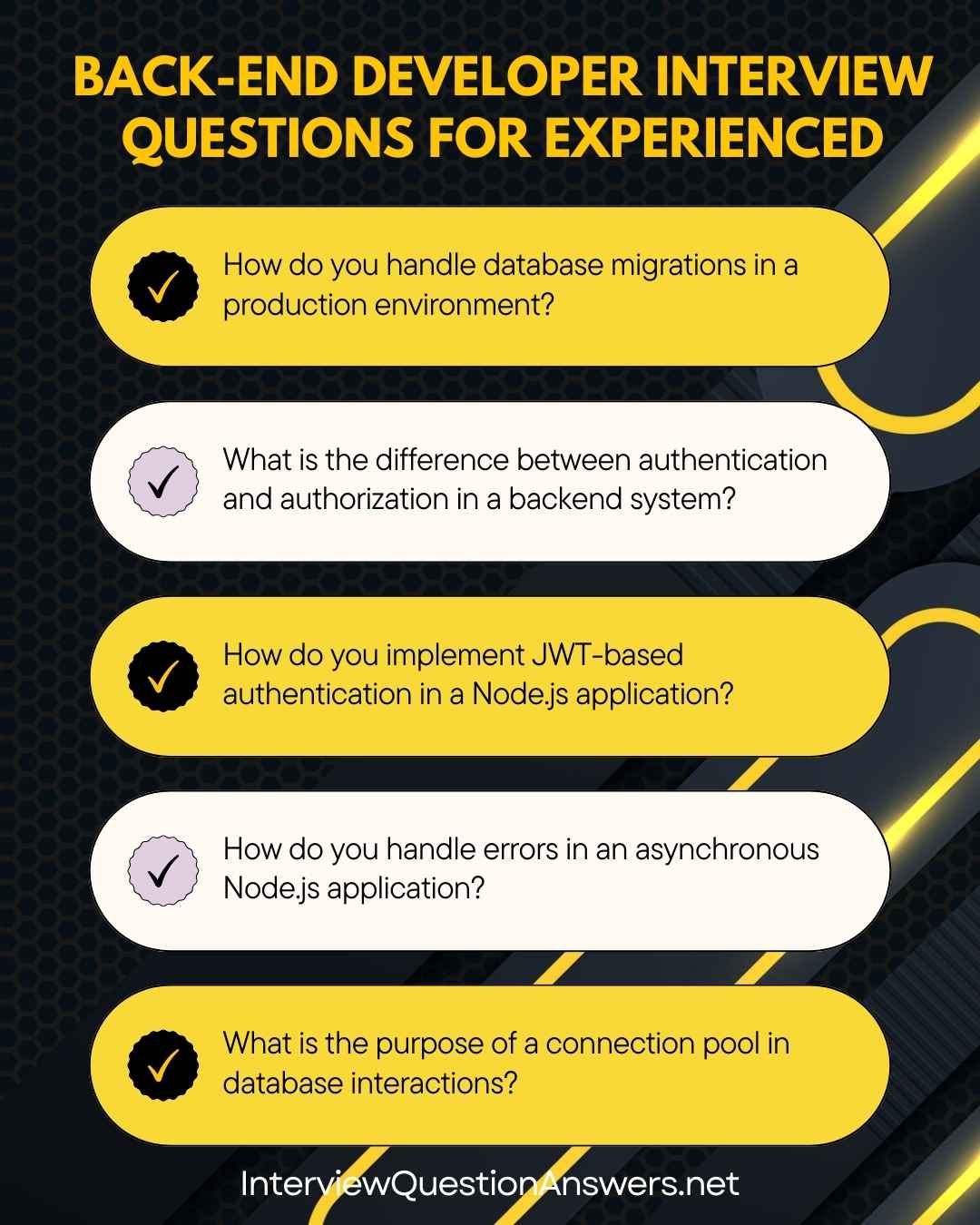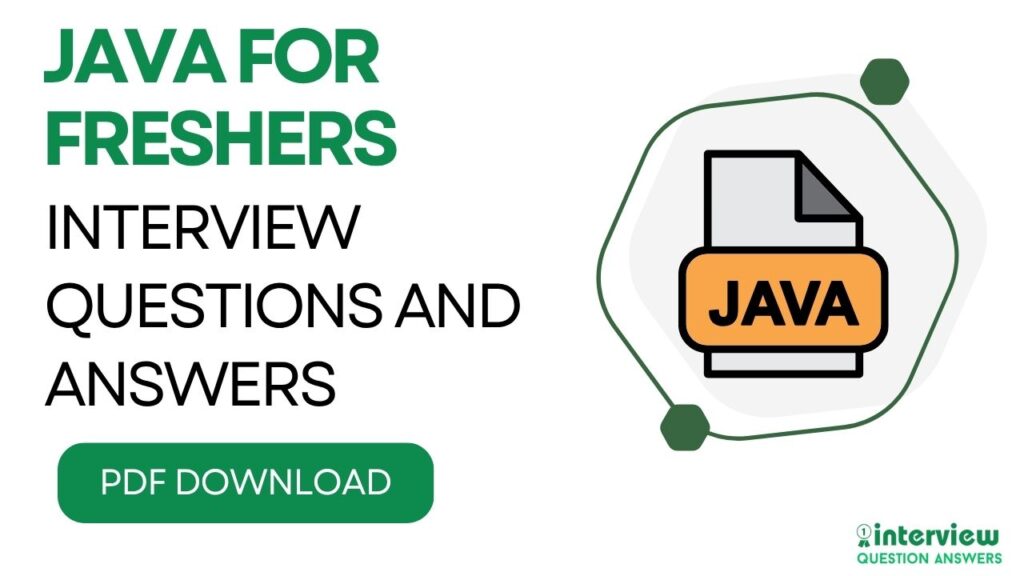Backend Developer Interview Questions for Experienced
Backend Developer Interview Questions for Experienced professionals examine deep technical knowledge, system scaling solutions, and engineering leadership qualities that senior developers must possess. Advancing to senior backend positions demands proving your ability to design robust server architectures and mentor development teams successfully.
Here we are covering Backend Developer Interview Questions for Experienced engineers who have maintained production systems, covering distributed computing frameworks, microservice implementations, performance tuning strategies, and technical decision-making processes.
These Back-End Developer Interview Questions for Experienced practitioners will enable you to highlight your expertise, demonstrate measurable system improvements, and establish your readiness for leadership roles in sophisticated backend engineering environments.
Table of Contents
Back End Developer Interview Questions for 2 Years Experience
Que 1. How do you design a REST API to handle high request volumes?
Answer:
Use stateless endpoints, implement caching with Redis, and optimize database queries with indexing. Employ load balancing (e.g., Nginx) and scale horizontally with tools like Docker. Monitor performance with Prometheus to identify bottlenecks.
const express = require('express');
const app = express();
app.get('/api/users', async (req, res) => {
const cached = await redis.get('users');
if (cached) return res.json(JSON.parse(cached));
const users = await db.query('SELECT * FROM users');
await redis.set('users', JSON.stringify(users), 'EX', 3600);
res.json(users);
});Que 2. How do you handle database migrations in a production environment?
Answer:
Use tools like Flyway or Sequelize migrations to apply incremental changes. Test migrations in a staging environment, backup the database, and use transactions to ensure consistency. Plan rollback strategies for failures.
// Sequelize migration example
module.exports = {
up: async (queryInterface, Sequelize) => {
await queryInterface.createTable('users', {
id: { type: Sequelize.INTEGER, primaryKey: true },
name: Sequelize.STRING
});
},
down: async (queryInterface) => {
await queryInterface.dropTable('users');
}
};Que 3. What is the difference between authentication and authorization in a backend system?
Answer:
Authentication verifies user identity (e.g., JWT login). Authorization determines permissions (e.g., role-based access). Implement with middleware to check tokens and roles before granting access.
function authorize(role) {
return (req, res, next) => {
if (req.user.role !== role) return res.status(403).send('Forbidden');
next();
};
}Que 4. How do you implement JWT-based authentication in a Node.js application?
Answer:
Use jsonwebtoken to generate and verify tokens. Store tokens in HTTP-only cookies or headers, validate in middleware, and refresh tokens for extended sessions.
const jwt = require('jsonwebtoken');
app.post('/login', (req, res) => {
const user = { id: 1, name: 'John' };
const token = jwt.sign(user, process.env.JWT_SECRET, { expiresIn: '1h' });
res.json({ token });
});Que 5. How do you optimize SQL queries for better performance?
Answer:
Use indexes on frequently queried columns, avoid SELECT *, and use EXPLAIN to analyze query plans. Implement pagination and minimize joins to reduce load.
CREATE INDEX idx_user_id ON orders(user_id);
SELECT id, name FROM users WHERE id = 1;Que 6. How do you handle errors in an asynchronous Node.js application?
Answer:
Use try-catch with async/await, implement error-handling middleware, and return appropriate HTTP status codes. Log errors with Winston for debugging.
app.use(async (err, req, res, next) => {
console.error(err);
res.status(500).json({ error: 'Internal server error' });
});Que 7. What is the purpose of a connection pool in database interactions?
Answer:
A connection pool reuses database connections to reduce overhead and improve performance. Configure pool size based on application load and database limits.
const { Pool } = require('pg');
const pool = new Pool({
connectionString: process.env.DATABASE_URL,
max: 20
});Que 8. How do you implement file uploads in a Python Flask application?
Answer:
Use Flask’s request.files to handle uploads, validate file types, and store in a filesystem or cloud storage like AWS S3.
from flask import Flask, request
app = Flask(__name__)
@app.route('/upload', methods=['POST'])
def upload_file():
file = request.files['file']
if file and file.filename.endswith('.jpg'):
file.save('uploads/' + file.filename)
return {"message": "File uploaded"}
return {"error": "Invalid file"}, 400Que 9. How do you secure sensitive data in a backend application?
Answer:
Encrypt data with libraries like crypto (Node.js) or cryptography (Python), store secrets in environment variables or vaults (e.g., AWS Secrets Manager), and use HTTPS. Implement least-privilege access.
const crypto = require('crypto');
const encrypted = crypto.createHmac('sha256', process.env.SECRET).update('data').digest('hex');Que 10. What is the difference between REST and GraphQL APIs?
Answer:
REST uses multiple endpoints with fixed responses, while GraphQL uses a single endpoint, allowing clients to request specific data. GraphQL reduces over/under-fetching but requires more setup.
// GraphQL example with Apollo
const { ApolloServer, gql } = require('apollo-server');
const typeDefs = gql`type Query { hello: String }`;
const server = new ApolloServer({ typeDefs, resolvers: { Query: { hello: () => 'Hello' } } });Backend Developer Interview Questions for 3 Years Experience
Que 11. How do you implement pagination in a backend API?
Answer:
Use query parameters like page and limit, apply OFFSET and LIMIT in SQL queries, and return metadata like total count.
app.get('/api/users', async (req, res) => {
const page = parseInt(req.query.page) || 1;
const limit = 10;
const offset = (page - 1) * limit;
const users = await db.query('SELECT * FROM users LIMIT $1 OFFSET $2', [limit, offset]);
res.json({ users, page, total: users.count });
});Que 12. How do you handle CORS in a backend application?
Answer:
Enable CORS with specific origins or allow all using middleware like cors in Express or Flask-CORS in Python. Configure headers for security.
const cors = require('cors');
app.use(cors({ origin: 'http://frontend.com' }));Que 13. What is the purpose of a reverse proxy in a backend system?
Answer:
A reverse proxy (e.g., Nginx) routes client requests to appropriate servers, providing load balancing, caching, and security. It hides backend architecture and improves performance.
server {
listen 80;
location / {
proxy_pass http://backend:3000;
}
}Que 14. How do you implement logging in a backend application?
Answer:
Use structured logging with Winston (Node.js) or Python’s logging module. Log to files or services like ELK, including request IDs for traceability.
import logging
logging.basicConfig(filename='app.log', level=logging.INFO)
logging.info('Request processed', extra={'request_id': '123'})Que 15. How do you handle database connection failures gracefully?
Answer:
Implement retry logic with exponential backoff, use connection pooling, and log errors. Provide fallback responses or queue tasks for later processing.
const { Pool } = require('pg');
const pool = new Pool({ connectionString: process.env.DATABASE_URL });
pool.on('error', (err) => console.error('DB error:', err));Que 16. What is the difference between a session-based and token-based authentication?
Answer:
Session-based authentication stores user data on the server, using session IDs in cookies. Token-based (e.g., JWT) is stateless, storing data in client-side tokens, scalable but requires secure handling.
Que 17. How do you validate API inputs in a backend application?
Answer:
Use libraries like Joi (Node.js) or pydantic (Python) to validate request data against schemas. Return clear error messages for invalid inputs.
const Joi = require('joi');
const schema = Joi.object({ name: Joi.string().required() });
app.post('/api/user', (req, res) => {
const { error } = schema.validate(req.body);
if (error) return res.status(400).send(error.details[0].message);
});Que 18. How do you implement a basic message queue for asynchronous tasks?
Answer:
Use RabbitMQ or AWS SQS to queue tasks. Producers send messages, and consumers process them asynchronously, improving scalability.
import pika
connection = pika.BlockingConnection(pika.ConnectionParameters('localhost'))
channel = connection.channel()
channel.queue_declare(queue='tasks')
channel.basic_publish(exchange='', routing_key='tasks', body='Task')Que 19. What is the purpose of database normalization?
Answer:
Normalization organizes a database into tables to reduce redundancy and improve data integrity, following rules like 1NF, 2NF, and 3NF. It ensures efficient storage but may require joins.
Que 20. How do you test a backend API for reliability?
Answer:
Use Postman for manual testing, write automated tests with pytest or Mocha, and mock dependencies with unittest.mock or sinon. Test edge cases and integrate with CI/CD.
import pytest
import requests
def test_api():
response = requests.get('http://localhost:3000/api/users')
assert response.status_code == 200
assert len(response.json()) > 0
Also check: Back End Developer Interview Questions for Freshers
Backend Developer Interview Questions for 5 Years Experience
Que 21. How do you design a scalable backend system to handle high traffic?
Answer:
Design with microservices deployed on Kubernetes for horizontal scaling, using load balancers (e.g., AWS ALB) to distribute traffic. Implement caching with Redis, optimize database queries with sharding or indexing, and use asynchronous processing with message queues like Kafka. Monitor with Prometheus and Grafana for performance insights.
# Kubernetes deployment example
apiVersion: apps/v1
kind: Deployment
metadata:
name: api-service
spec:
replicas: 5
template:
spec:
containers:
- name: api
image: my-api:latestQue 22. How do you implement database transactions across distributed systems?
Answer:
Use distributed transactions with the Saga pattern, coordinating via events (e.g., Kafka) or compensating transactions. Ensure idempotency and implement retry mechanisms. Alternatively, use two-phase commit for strict consistency, though it’s less common due to complexity.
// Kafka event for Saga
const { Kafka } = require('kafkajs');
const kafka = new Kafka({ clientId: 'app', brokers: ['localhost:9092'] });
const producer = kafka.producer();
await producer.send({
topic: 'order-events',
messages: [{ value: JSON.stringify({ orderId: 1, status: 'created' }) }]
});Que 23. How do you secure sensitive data in transit and at rest in a backend system?
Answer:
Use HTTPS with TLS for data in transit and encrypt sensitive data at rest with AES (e.g., AWS KMS). Store secrets in a vault (e.g., HashiCorp Vault) and implement least-privilege IAM roles. Audit access with tools like AWS CloudTrail.
const crypto = require('crypto');
const cipher = crypto.createCipher('aes-256-cbc', process.env.KEY);
let encrypted = cipher.update('data', 'utf8', 'hex');
encrypted += cipher.final('hex');Que 24. How do you handle API versioning in a production environment?
Answer:
Version APIs via URL paths (e.g., /v1/users), headers, or query parameters. Maintain backward compatibility, document changes in OpenAPI specs, and deprecate old versions with clear timelines. Use feature flags for gradual rollouts.
app.get('/api/v1/users', (req, res) => {
res.json({ version: 'v1', users: [] });
});Que 25. How do you implement rate limiting to prevent API abuse?
Answer:
Use middleware like express-rate-limit or flask-limiter with Redis to track request counts per user/IP. Configure limits (e.g., 100 requests/hour) and return 429 status codes for exceeded limits.
from flask_limiter import Limiter
app = Flask(__name__)
limiter = Limiter(app, key_func=lambda: request.remote_addr)
@app.route('/api', methods=['GET'])
@limiter.limit("100/hour")
def api():
return {"message": "Success"}Que 26. How do you optimize a backend application for low-latency responses?
Answer:
Cache responses with Redis, use efficient indexing in databases, and minimize I/O operations. Implement asynchronous processing with Node.js or Python’s asyncio, and use CDNs for static assets. Profile with tools like New Relic to identify bottlenecks.
const redis = require('redis');
const client = redis.createClient();
app.get('/api/data', async (req, res) => {
const cached = await client.get('data');
if (cached) return res.json(JSON.parse(cached));
const data = await db.query('SELECT * FROM data');
await client.setEx('data', 3600, JSON.stringify(data));
res.json(data);
});Que 27. How do you implement a message queue system for asynchronous task processing?
Answer:
Use RabbitMQ or AWS SQS to queue tasks, with producers sending messages and consumers processing them. Implement retries and dead-letter queues for fault tolerance. Monitor with CloudWatch or Prometheus.
import pika
connection = pika.BlockingConnection(pika.ConnectionParameters('localhost'))
channel = connection.channel()
channel.queue_declare(queue='tasks', arguments={'x-dead-letter-exchange': 'dlx'})
channel.basic_publish(exchange='', routing_key='tasks', body='Task data')
connection.close()Que 28. How do you handle database deadlocks in a production environment?
Answer:
Detect deadlocks with database logs (e.g., PostgreSQL’s pg_stat_activity). Prevent with consistent resource ordering, short transactions, and retry logic. Use lower isolation levels (e.g., READ COMMITTED) when appropriate.
SET TRANSACTION ISOLATION LEVEL READ COMMITTED;
BEGIN;
-- Operations
COMMIT;Que 29. How do you design a backend system to support real-time features?
Answer:
Use WebSockets (e.g., socket.io) or Server-Sent Events for real-time updates. Implement pub/sub with Redis or Kafka for scalability, and ensure state consistency with optimistic updates. Monitor latency with Datadog.
const io = require('socket.io')(server);
io.on('connection', (socket) => {
socket.on('message', (msg) => io.emit('message', msg));
});Que 30. How do you implement logging for a distributed backend system?
Answer:
Use centralized logging with ELK Stack or Fluentd, implementing structured logging with Winston or Python’s logging. Correlate logs with request IDs and monitor with dashboards in Grafana.
const winston = require('winston');
const logger = winston.createLogger({
transports: [new winston.transports.File({ filename: 'app.log' })],
format: winston.format.combine(
winston.format.json(),
winston.format.metadata()
)
});
logger.info('Request processed', { requestId: '123' });Backend Developer Interview Questions for 7 Years Experience
Que 31. How do you handle large file uploads in a backend application?
Answer:
Use chunked uploads with streams, store files in cloud storage (e.g., AWS S3), and validate file types. Implement resumable uploads with presigned URLs and track progress in a database.
const { S3 } = require('aws-sdk');
const s3 = new S3();
app.post('/upload', async (req, res) => {
const params = { Bucket: 'my-bucket', Key: req.file.name, Body: req.file.stream };
await s3.upload(params).promise();
res.send('Uploaded');
});Que 32. What is the Circuit Breaker pattern, and how do you implement it?
Answer:
The Circuit Breaker pattern prevents cascading failures by halting requests to a failing service. Use libraries like resilience4j (Java) or node-circuitbreaker. Monitor thresholds and fallback to alternate logic.
const { CircuitBreaker } = require('cockatiel');
const breaker = new CircuitBreaker({ halfOpenAfter: 5000 });
app.get('/api', async (req, res) => {
try {
const result = await breaker.execute(() => callExternalService());
res.json(result);
} catch (err) {
res.status(503).send('Service unavailable');
}
});Que 33. How do you implement API authentication with OAuth 2.0?
Answer:
Use an OAuth provider (e.g., Auth0, Keycloak) to issue access tokens. Validate tokens in middleware, and use scopes for authorization. Refresh tokens for session continuity.
const { expressjwt } = require('express-jwt');
app.use(expressjwt({
secret: process.env.JWT_SECRET,
algorithms: ['HS256']
}));Que 34. How do you optimize a database for read-heavy workloads?
Answer:
Use read replicas for load distribution, cache queries with Redis, and index frequently queried columns. Implement materialized views for complex queries and monitor performance with database metrics.
CREATE INDEX idx_user_email ON users(email);Que 35. How do you implement a GraphQL API in a backend system?
Answer:
Use Apollo Server or Graphene to define schemas and resolvers. Optimize with DataLoader for batching and caching, and secure with authentication middleware.
const { ApolloServer, gql } = require('apollo-server');
const typeDefs = gql`
type Query {
users: [User]
}
type User { id: ID, name: String }
`;
const resolvers = {
Query: { users: () => db.query('SELECT * FROM users') }
};
const server = new ApolloServer({ typeDefs, resolvers });
server.listen();Que 36. How do you handle cross-service communication in a microservices architecture?
Answer:
Use REST, gRPC, or message queues (e.g., Kafka) for communication. Implement circuit breakers for fault tolerance, use API gateways for routing, and ensure idempotency for reliable retries.
# Kafka producer example
from kafka import KafkaProducer
producer = KafkaProducer(bootstrap_servers='localhost:9092')
producer.send('service-topic', value=b'{"id": 1}')Que 37. How do you test a backend system for scalability?
Answer:
Perform load testing with tools like JMeter or Locust, simulating high traffic. Monitor with Prometheus, analyze bottlenecks, and scale with Kubernetes. Test failover scenarios with chaos engineering tools like Chaos Mesh.
# Locust load test example
from locust import HttpUser, task
class ApiUser(HttpUser):
@task
def get_users(self):
self.client.get("/api/users")Que 38. How do you ensure data consistency in a NoSQL database?
Answer:
Use eventual consistency with conflict resolution (e.g., versioning, CRDTs). Implement idempotent operations, leverage DynamoDB streams for updates, and monitor with read-after-write checks.
const AWS = require('aws-sdk');
const dynamo = new AWS.DynamoDB.DocumentClient();
dynamo.update({
TableName: 'Users',
Key: { id: '1' },
UpdateExpression: 'SET version = version + :inc',
ConditionExpression: 'version = :current',
ExpressionAttributeValues: { ':inc': 1, ':current': currentVersion }
});Que 39. How do you implement observability in a backend system?
Answer:
Use distributed tracing with Jaeger, metrics with Prometheus, and logging with ELK Stack. Implement correlation IDs for request tracking and visualize with Grafana dashboards.
app.use((req, res, next) => {
req.correlationId = crypto.randomUUID();
logger.info('Request', { correlationId: req.correlationId });
next();
});Que 40. How do you migrate a monolithic backend to a microservices architecture?
Answer:
Refactor incrementally using the Strangler pattern, extracting services by domain. Use API gateways for routing, containerize with Docker, and deploy with Kubernetes. Test with integration tests and monitor for performance regressions.
# Docker Compose for microservices
version: '3'
services:
user-service:
image: user-service:latest
ports:
- "3001:3000"Backend Developer Interview Questions for 10 Years Experience
Que 41. How do you architect a backend system to handle millions of requests per second?
Answer:
Design with microservices on Kubernetes for horizontal scaling, using load balancers (e.g., AWS NLB) for traffic distribution. Implement caching with Redis, sharding in databases like Cassandra, and asynchronous processing with Kafka. Optimize with gRPC for low-latency communication and monitor with Prometheus and Grafana for real-time insights.
# Kubernetes service with load balancer
apiVersion: v1
kind: Service
metadata:
name: api-service
spec:
type: LoadBalancer
ports:
- port: 80
targetPort: 3000
selector:
app: apiQue 42. How do you ensure zero-downtime deployments in a high-traffic backend system?
Answer:
Use blue-green deployments or canary releases with Kubernetes, leveraging rolling updates and health checks. Implement feature flags with LaunchDarkly, automate with ArgoCD, and monitor with Datadog to detect issues. Cache assets in CDNs to reduce load during deployments.
# ArgoCD canary deployment
apiVersion: argoproj.io/v1alpha1
kind: Rollout
spec:
strategy:
canary:
steps:
- setWeight: 10
- pause: {duration: 5m}Que 43. How do you design a backend system for real-time data processing at scale?
Answer:
Use Apache Kafka or AWS Kinesis for streaming, process with Apache Flink or Spark Streaming, and store in a scalable database like DynamoDB. Implement fault tolerance with retries and dead-letter queues, and monitor latency with Prometheus.
# Kafka consumer
from kafka import KafkaConsumer
consumer = KafkaConsumer('data-stream', bootstrap_servers='localhost:9092')
for msg in consumer:
process_data(msg.value)Que 44. How do you implement observability in a distributed backend system?
Answer:
Use distributed tracing with Jaeger or Zipkin, metrics with Prometheus, and centralized logging with ELK Stack. Implement correlation IDs for request tracking, visualize with Grafana, and set up alerts for proactive monitoring.
const express = require('express');
const app = express();
app.use((req, res, next) => {
req.correlationId = require('crypto').randomUUID();
logger.info('Request', { correlationId: req.correlationId });
next();
});Que 45. How do you secure a backend system against advanced threats like DDoS and data breaches?
Answer:
Use AWS WAF or Cloudflare for DDoS protection, encrypt data with KMS, and store secrets in HashiCorp Vault. Implement zero-trust with mTLS, audit with CloudTrail, and scan for vulnerabilities with Snyk. Enforce rate limiting and monitor anomalies with SIEM tools.
const rateLimit = require('express-rate-limit');
app.use(rateLimit({
windowMs: 15 * 60 * 1000, // 15 minutes
max: 1000
}));Que 46. How do you migrate a legacy monolithic backend to a microservices architecture?
Answer:
Apply the Strangler pattern, extracting services incrementally by domain. Use API gateways (e.g., Kong) for routing, containerize with Docker, and orchestrate with Kubernetes. Implement event-driven communication with Kafka and test with chaos engineering to ensure reliability.
# Docker Compose for microservice
version: '3'
services:
order-service:
image: order-service:latest
ports:
- "3001:3000"Que 47. How do you implement a fault-tolerant backend system in a cloud environment?
Answer:
Use multi-region deployments with AWS Global Accelerator, implement circuit breakers with Resilience4j, and ensure data replication with DynamoDB Global Tables. Test resilience with Chaos Monkey and monitor with CloudWatch for failover detection.
const { CircuitBreaker } = require('cockatiel');
const breaker = new CircuitBreaker({ halfOpenAfter: 5000 });
app.get('/api', async (req, res) => {
try {
const result = await breaker.execute(() => callService());
res.json(result);
} catch (err) {
res.status(503).send('Service unavailable');
}
});Que 48. How do you optimize a backend system for low-latency database operations?
Answer:
Use in-memory databases like Redis for caching, implement read replicas for load distribution, and optimize queries with indexing and query plans. Use connection pooling and batch operations to reduce overhead, and profile with New Relic.
CREATE INDEX idx_orders_date ON orders(created_at);Que 49. How do you implement a secure CI/CD pipeline for a backend system?
Answer:
Use GitHub Actions or Jenkins, store secrets in AWS Secrets Manager, and enforce branch protection. Scan code with SonarQube, deploy with Terraform, and monitor pipeline logs with CloudWatch. Use signed commits for security.
# GitHub Actions pipeline
name: CI/CD
on: [push]
jobs:
deploy:
runs-on: ubuntu-latest
steps:
- uses: actions/checkout@v3
- run: terraform apply -auto-approve
env:
AWS_ACCESS_KEY_ID: ${{ secrets.AWS_ACCESS_KEY_ID }}Que 50. How do you design a backend system to support multi-tenant architecture?
Answer:
Use schema-based or table-based tenancy in databases, isolate tenant data with namespaces, and implement RBAC for access control. Use API gateways to route tenant-specific requests and monitor with tenant-specific metrics in Prometheus.
app.use((req, res, next) => {
const tenantId = req.header('X-Tenant-ID');
req.db = connectToTenantDb(tenantId);
next();
});Conclusion
The backend development landscape transforms continuously with containerized deployments, event-driven architectures, and observability platforms establishing higher standards for senior-level roles. These Backend Developer Interview Questions for Experienced engineers deliver the strategic preparation essential for career advancement, spanning complex database optimization to infrastructure management. Through dedicated preparation with these Backend Developer Interview Questions for Experienced and mastery of evolving backend technologies, you will achieve excellence in securing senior backend development positions.
You can also check:













